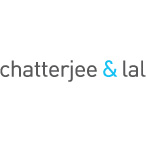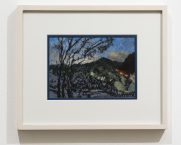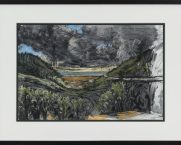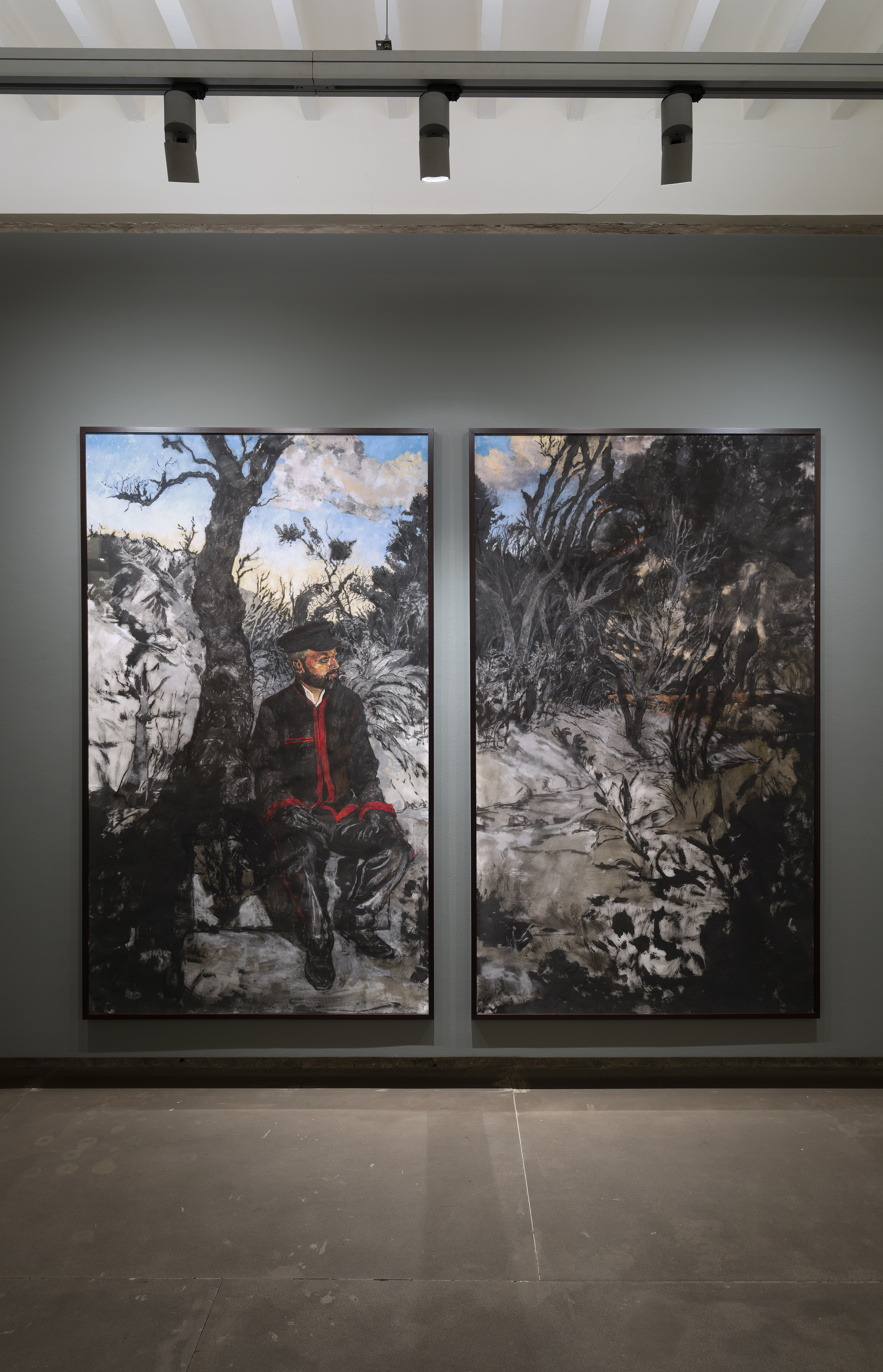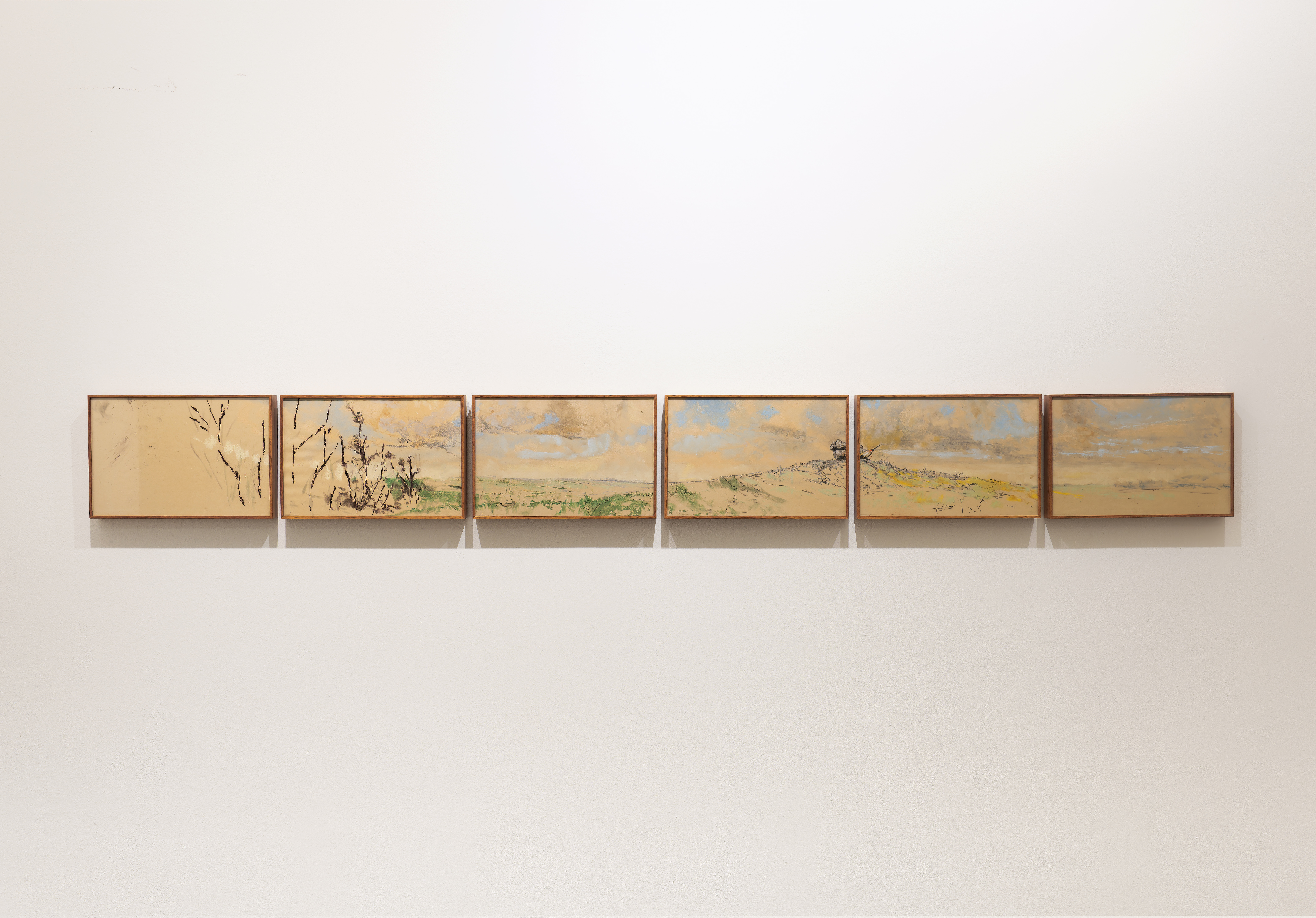C&L Shows
Line of Fire
Nikhil Chopra
2024

Overview
The landscapes in Nikhil Chopra’s recent works are interrupted by the presence of his past selves. These meander, dwell, or come to rest on these surfaces. Lost in thought, staring you in the eye or as apparitions, these are spirits of lives he’s embodied or engaged with in his durational performances over the decades. This presence ruptures the stillness of landscape paintings, as well as the linearity of time to provide a possibility, a portal, for introspection and time travel – in retrospect and in the present. With the change in times and conditions, these personas now displaced are ridden with anxiety and uncertainty. There is a visible exhaustion. Or are they dejected with where we stand now? This spillage also enables a collision of histories and memories.
The landscape is no longer lush and dreamy, it rages and burns to black under red-yellow flames and clouds of grey. Fires burn to remind us of primitivity, of coming together and warmth, of invention, but also war and strife, and natural disaster. Charcoal then, a product of charred trees, remains a medium close to this destruction of the pastoral and natural worlds. History in Chopra’s life and works remains speculative and revels in the possibility of mythologies and fictions. He summons personas and iconographies to serve as shells to inhabit and embody; and distils hard facts into dreamy visions and nightmares, lucid and instinctive. It flows and sways, whilst remaining deeply personal, and situated, on his body.
In Blackening 3157 a man catches a moment of rest in a charred forest. He is lost in thought, his eyes heavy. He mourns perhaps or is anxious. We have met this man before in 2017. He wears the uniform of a ticket collector working for the British empire in North Western Railways in undivided India. He is both a subject and the servant of the state. Chopra performed at the Museum of Science and Industry in Manchester in 2017, connecting his life to the retired locomotive number 3157. The carriage was built in 1911 in the Vulcan foundry and connected Punjab, Sindh and Delhi in pre-partition India – and possibly carried passengers to both sides of the border during the bloody partition. The machine is both witness and evidence to the violence of a colonial past and the transition of these countries into freedom. For Chopra it symbolises an inherited, shared history. 3157 was in use until 1982 and was gifted to the museum in Manchester by the General Zia-ul Haq government. The afterlife of objects and events continue to interest Chopra. To be clear, he is not interested in the event itself, but the possibility of what it triggers in its aftermath.
In Line of Fire: I people swim in the bay. Chopra’s recent visits to Vietnam started an investigation into the lives of these former colonial territories in the aftermath of the war. There is a concerted recalibration of these pasts to accommodate their present lives as tourist havens – in Goa, Vietnam and Kashmir. Chopra is struck by the failure of popular culture, especially Western Cinema’s portrayal of America’s war against Vietnam. The war on celluloid was almost always in the background, a setting against which the lives of protagonists would play out. It would be alluded to obliquely. Images of people displaced from war and natural calamity and finding refuge by the sea have circulated across social media in recent years. In the absence of safe asylum on land, the sea offers both comfort and the opportunity to wash the war off one’s skin. It is also a reclamation – an anchoring that a shore provides with the embalming sea. Salt disinfects and heals.
Tourism here must not be confused with war tourism, for the intention is to not address the war actively (or at all). It is to provide a sensation of safety in the suppleness of a tropical paradise where much like Goa – the sea, food and adventure along with pastoral life – are used to overshadow colonial pasts. The fields are laden with mines, but we must talk about rice. The remains of imperialism or of war become backdrops for photographs, but are never actively discussed or encountered in its full historical measure. The narrative is actively compromised. How much talk of war is enough before it becomes uncomfortable?
In his smaller works on paper scenes from travels and places he has engaged with over the years are overlaid with signs of change, or the presence of fear and looming danger. The geometry of infrastructural development sits atop the lushness of nature – a road curving along the mountain or an electricity grid. In others a missile pierces through the skies or crashes and burns in the distance. It could also be a forest fire, like those that have blazed through the hot summers of Goa and elsewhere. In Line of Fire VIII, the ominous grey-blue waters at twilight reflect the red of a sinking sun or is it the blood from “when a whale killed a seal”. This spillage is both literal and conceptual – to allow for death and regeneration. Like the earth, our bodies are also largely salt water. Our blood plasma is not very different from the sea. There is also an attempt at the reduction of the landscape, a distillation and reduction of forms to lines like the landscape is slowly being abstracted like in Line of Fire III. This shift from the fullness of nature to the bareness of its skeletal anatomy, commemorating the violent extraction and exploitation of resources – of mining to the bone. This reduction also extends the view, opening the distance between us and our pasts.
At 47-A, Chopra’s durational performance derives from his constant coming to terms with the expected publicness of his private studio life. Set against a glass window, and in full view to passers-by, he draws wearing an ambiguous, metallic costume. His garment alluding to the lead, aluminium, chromium, and cadmium found in the lipsticks with which he is drawing. As he rubs the cosmetic product against the glass a synthetic smell, almost intoxicating, fills the space. A long-term exposure and frequent use can lead to the accumulation of these toxic heavy metals in our bodies. A soundscape of natural and unnatural sounds fills the space – gushing winds carrying birds are interrupted by gunshots and planes passing – as an acute awareness of threat. With the layering of lipstick over lipstick and sound over sound, Chopra builds an uncomfortable, cyclical density. It envelopes us now.
Chopra’s performance is about this accumulation and that of toxic histories and ecological contamination. His landscapes, saturated, and in solarized hues of lipstick stand testament to these. As he slowly presses gateway papers used for architectural planning onto the lipstick drawings, the opacity sharpens the image. It is as though, exhausted, he is shutting us out again while leaving us with a vision. These papers over time also absorb and gather the image as an imprint, providing stillness and stability to the agility and unpredictability of performance.
Chopra started out with pastels and charcoal as his first materials and remained with it – consistently experimenting with scale and texture. For him, the potential of these materials and mediums and his own practice grew from performing in public spaces. It is and I quote “where I learnt the most. My biggest art school has been the live school. To throw myself into the open space,” notes Chopra. In the live space he continues, there is no judgment – “no right or wrong. No mistakes. No finished or unfinished – to be just asked to create freely” – to move and/or to lay still, to breathe.
Line of Fire is less of a return and more of an arrival for Chopra – where accumulated material from across time and space pass through one another, fearlessly. The landscape is no longer stable – it extends, collapses, and combusts – but also provides the possibility of regeneration or perhaps fossilization.
~ Mario D’Souza
A Video Walkthrough by Mort Chatterjee
